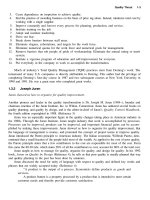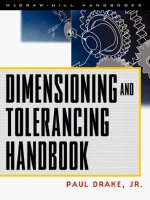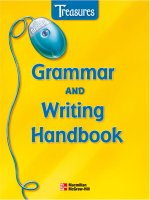MCGraw Hill-Dimensioning and Tolerancing Handbook
Bạn đang xem bản rút gọn của tài liệu. Xem và tải ngay bản đầy đủ của tài liệu tại đây (8.11 MB, 734 trang )
Dimensioning and Tolerancing
Handbook
Paul J. Drake, Jr.
McGraw-Hill
New York
San Francisco Washington , D.C. Auckland Bogata
Caracas Lisbon London Madrid Mexico City Milan
Montreal New Delhi San Juan Singapore
Sydney Tokyo Toronto
McGraw-Hill
A Division of The McGraw-Hill Companies
Copyright 1999 by Paul J. Drake, Jr. All rights reserved. Printed in the United States
of America. Except as permitted under the United States Copyright Act of 1976, no part
of this publication may be reproduced or distributed in any form or by any means, or
stored in a data base or retrieval system, without the prior written permission of the
publisher.
1 2 3 4 5 6 7 8 9 0 QM/QM 9098765432109
ISBN 0-07-018131-4
The sponsoring editor of this book was Linda Ludewig, and the production supervisor
was Pamela Pelton.
Printed and bound by Quebecor/Martinsburg.
This book is printed on recycled, acid-free paper containing a minimum of
50% recycled, de-inked fiber.
McGraw-Hill books are available at special quantity discounts to use as premiums and
sales promotions, or for use in corporate training programs. For more information,
please write to the Director of Special Sales, McGraw-Hill, 11 West 19th Street, New
York, NY 100011. Or contact your local bookstore.
Information contained in this work has been obtained by The McGraw-Hill Companies,
Inc. (“McGraw-Hill”) from sources believed to be reliable. However, neither McGrawHill nor its authors guarantees the accuracy or completeness of any information published herein and neither McGraw-Hill nor its authors shall be responsible for any errors,
omissions, or damages arising out of use of this information. This work is published with
the understanding that McGraw-Hill and its authors are supplying information but are
not attempting to render engineering or other professional services. If such services are
required, the assistance of an appropriate professional should be sought.
About the Editor
Paul Drake is a Principal Engineer with Honors at the Raytheon Systems Company where he trains and
consults in variation management, GD&T and Six Sigma mechanical tolerancing. He began the Mechanical Tolerancing and Performance Sigma Center for Excellence at Raytheon (formerly Texas Instruments,
Inc.) in 1995. This center develops and deploys dimensioning and tolerancing best practices within
Raytheon. As a member of the Raytheon Learning Institute, Paul has trained more than 3,500 people in
GD&T and mechanical tolerancing in the past 12 years. He has also written numerous articles and
design guides on optical and mechanical tolerancing.
Paul has ASME certification as a Senior Level GD&T Professional. He is a Subject Matter Expert
(SME3) to ASME’s Statistical Tolerancing Technical Subcommittee, a member of ASME’s Geometric
Dimensioning and Tolerancing Committee, a Six Sigma Blackbelt, and a licensed professional engineer in
Texas. He holds two patents related to mechanical tolerancing.
Paul resides in Richardson, Texas, with his wife Jane and their three children.
xxii
Contributors
Timothy V. Bogard
Sigmetrix
Dallas, Texas
Chapter 26
Gregory A. Hetland, Ph.D.
Hutchinson Technology Inc.
Hutchinson, Minnesota
Chapters 3, 20, 25, and 26
Kenneth W. Chase, Ph.D.
Brigham Young University
Provo, Utah
Chapters 13, 14, and 26
Michael D. King
Raytheon Systems Company
Plano, Texas
Chapter 17
Tom S. Cheek, Jr., Ph.D
Six Sigma Design Institute
Dallas, Texas
Reviewer
Alex Krulikowski
General Motors Corporation
Westland, Michigan
Chapter 6
Chris Cuba
Raytheon Systems Company
McKinney, Texas
Chapter 23
Marvin Law
Raytheon Systems Company
Dallas, Texas
Chapter 15
Gordon Cumming
Raytheon Systems Company
McKinney, Texas
Reviewer
Percy Mares
Boeing
Huntington Beach, California
Reviewer
Don Day
Monroe Community College
Rochester, NY
Chapter 26
Paul Matthews
Ultrak
Lewisville, TX
Chapter 16
Scott DeRaad
General Motors Corporation
Ann Arbor, Michigan
Chapter 6
Patrick J. McCuistion, Ph.D
Ohio University
Athens, Ohio
Chapter 4
Paul Drake
Raytheon Systems Company
Plano, Texas
Chapters 5, 9, and 26
James D. Meadows
Institute for Engineering & Design, Inc.
Hendersonville, Tennessee
Chapter 19
Charles Glancy
Raytheon Systems Company
Dallas, Texas
Chapter 15
Jack Murphy
Raytheon Systems Company
Dallas, Texas
Reviewer
xxiii
xxiv
Contributors
Mark A. Nasson
Draper Laboratory
Cambridge, Massachusetts
Chapter 7
Dale Van Wyk
Raytheon Systems Company
McKinney, Texas
Chapters 11 and 12
Al Neumann
Technical Consultants, Inc.
Longboat Key, Florida
Chapter 26
Stephen Harry Werst
Raytheon Systems Company
Dallas, Texas
Chapter 24
Robert H. Nickolaisen, P.E.
Dimensional Engineering Services
Joplin, Missouri
Chapter 2
Robert Wiles
Datum Inspection Services
Phoenix, Arizona
Reviewer
Ron Randall
Ron Randall & Associates, Inc.
Dallas, Texas
Chapters 1 and 10
Bruce A. Wilson
Aerospace Industry
St. Louis, Missouri
Chapter 26
Vijay Srinivasan, Ph.D
IBM Research and Columbia University
New York
Chapter 8
Martin P. Wright
Behr Climate Systems, Inc.
Fort Worth, Texas
Chapter 18
Walter M. Stites
AccraTronics Seals Corp.
Burbank, California
Chapter 5
Paul Zimmermann
Raytheon Systems Company
McKinney, Texas
Chapter 22
James Stoddard
Raytheon Systems Company
Dallas, Texas
Chapter 15
Dan A. Watson, Ph.D.
Texas Instruments Incorporated
Dallas, Texas
Chapter 21
Acknowledgments
I am grateful to the authors for their personal sacrifices and time they dedicated to this project. I am
especially grateful to four people who have influenced my personal life, my career, and the writing of this
book.
·
Jane Drake, my wife, for her tireless editing and unwavering support
·
Dr. Greg Hetland for his vision of the big picture
·
Walt Stites for his meticulous detail and understanding of Geometric Dimensioning
and Tolerancing
·
Dale Van Wyk for helping me understand statistical tolerancing
I am also grateful to the following people for their support and help in this effort.
·
Bob Esposito and Linda Ludewig from McGraw-Hill for their faith in this work
·
Sally Glover from McGraw-Hill for proofing the work
·
Mike Tinker, Ted Moody, and Rita Casavantes for their management support
·
Todd Flippin for his late-night help keeping the computers running
·
Gene Mancias for the wealth of graphic support
·
Kelli and Joe Mancuso (The Training Edge) for help with the layout and design
·
Scott Peters for his help with the index and printing
·
Douglas Winters III for his artistic talents, graphics, and cover design
I wish to thank the reviewers Tom Cheek, Gordon Cumming, Percy Mares, Jack Murphy, and Bob
Wiles for their careful and thorough review of this material.
I am deeply indebted to Lowell Foster, for his review and endorsement of this work.
I especially want to thank my wife, Jane, for her patience, endless hours of editing, and perseverance.
I could not have done this without her.
I wish to dedicate this book to God; my parents, Anne and Paul Drake; and my wife Jane and children
Taylor, Ellen, and Madeline.
xxix
Foreword
Between the covers of this remarkable text one can experience, at near warp speed, a journey through the
cosmos of subject matter dealing with dimensioning and tolerancing of mechanical products. The
editor, as one of the contributing authors, has aptly summarized the content broadly as “about product
variation.” The contained chapters proceed then to wend their way through the various subjects to
achieve that end. Under the individual pens of the authors, the wisdom, experience, writing style, and
extensive research on each of the concerned topics presents the subject details with a unique richness.
The authors, being widely renowned and respected in their fields of endeavor, combine to present a
priceless body of knowledge available at the fingertips of the reader.
If not a first, this text surely is one of the best ever compiled as a consolidation of the contained
related subjects. While possibly appearing a little overwhelming in its volume, the book succeeds in
putting the reader at ease through the excellent subject matter arrangement, sequential flowing of chapters, listing of contents, and a complete index. The details of each chapter are self-explanatory and
present “their story” in an enlightening, albeit challenging sometimes, individual style. Collectively, the
authors and their respective chapters seem to reflect considerations and lessons learned from the past,
inspiration and creativity for the state-of-the-art of the present, and insightful visions for the future. This
text then equally represents a kind of status report of the various involved technologies, guidance and
instruction for absorbing and implementing technical content, and some direction to the future path of
progress.
Reflecting upon the significant contribution this text adds to the current state of progress on the
contained subjects, a feeling of confidence prevails that there is no fear for the future— to the contrary,
only a relish for the enlarging opportunities time will provide. Congratulations to the editor, Paul Drake,
for his insight in conceiving this text and to all the authors and contributors. Your product represents a
major achievement in its addition to the annals of product engineering literature. It is also a record of our
times and a glimpse of the future. It is a distinct pleasure to endorse this text with added thanks for all the
dedicated energy expended in behalf of this project and the professions involved. Your work will bring
immediate returns and will also instill a pride of accomplishment on behalf of yourselves, our country, and
the global community of industrial technology.
Lowell W. Foster
Lowell W. Foster Associates, Inc.
Minneapolis, Minnesota
xxi
Preface
This book is about transitioning from mechanical product design to manufacturing. The cover graphic
illustrates two distinct phases of product development. The gear drawing (computer model) represents
a concept that is perfect. The manufactured gear is imperfect. A major barrier in the journey from
conceptual ideas to tangible products is variation. Variation can occur in the manufacturing of products,
as well as in the processes that are used to develop the products.
This book is about mechanical product variation: how we understand it, how we deal with it, and how
we control it. As the title suggests, this book focuses on documenting mechanical designs (dimensioning) and understanding the variation (tolerancing) within the product development process. If we accept all product variation into our design, our products may not function as intended. If we throw away
parts with too much variation, our product costs will increase.
This book is about how we balance product variation with customer requirements. We generally deal
with product variation in three ways.
• We accept product variation in our designs;
• We control product variation in our processes; or
• We screen out manufactured parts that have more variation than the design will allow.
Many experts refer to this balance between design requirements and manufacturing variation as
dimensional management. I prefer to call it variation management. After all, variation is usually the
primary contributor to product cost.
In order to manage variation we must understand how variation impacts the mechanical product
development process.
This book is process driven. This book is not just a collection of related topics. At the heart of this book
is the variation management process. Fig. P-1 shows a generic product development process, and
captures the key activities we put in place to manage product variation. Your product development
process may be similar in some areas and different in others, but I believe Fig. P-1 captures the essence of
the design process.
Fig. P-1 does not try to document everything in the variation management process. This information
is contained within the chapters. The purpose of Fig. P-1 is twofold; first, it gives a birds-eye view of the
process to help the reader understand the “big-picture,” and second, it is a starting point to show the
reader where each chapter in the book fits into this process.
xxv
xxvi
Preface
External Influences
- Customer defined
performance /
functional requirements
Internal
Influences
Supplier
Influences
- Internal
constraints
- Supplier
constraints
- Internal
standards
- Tooling
- Best practices
- Training
- National, international,
and industry standards
Verification/Test
- Piecepart
- Subassembly
- Full assembly
Analysis tools
- Attribute (Functional / paper gaging)
- Variable
Measurement
Assess measurement error
Feature based /
task specific
Product Design Cycle
Verification/Test
Document capabilities
- Machine tolerances /
specifications
- Process capabilities
Assembly
Subassembly
Full assembly
Design
Manufacturing
Components
Machining
Statistical
Process
Control
Mechanical Design (Product, Equipment, and Tooling)
System Design
Detailed Design
Understand functional
design requirements
Establish dimensioning and
tolerancing approach to
support functional needs
Tolerancing Methodology
- Worst case
- Root sum squared
- Six Sigma optimization
- Cost / yield optimization
Manual drawing layout (2-D)
or
Computer Aided Design (3-D)
Tolerance analysis tools
Tolerance re-allocation
Design documentation
Figure P-1 Product development process
Preface
xxvii
Each chapter of this book is linked to the product development process. The book is divided into seven
parts that map to the process. Each chapter details the activities associated with the variation management process. By no means does this book capture everything. Although there is a wealth of information
here, there is an endless amount of information that we could add. Likewise, new techniques, processes,
and technologies will continue to evolve.
Although each chapter is a piece of the variation management puzzle, each chapter can stand alone.
In practice, however, it is important to understand how each piece of the puzzle relates to others.
This book is about assessing design risk. If we understand the sources of product variation, and we
understand the process(es) to manage them, we are well on our way to designing competitive products
that meet customer requirements. If we capture the sources of variation and input these into the design
process, we can assess the risk of meeting the manufacturing requirements as well as the performance of
our designs.
Several experts contributed to this book. Each chapter reflects a wealth of experience from its author(s),
many of whom are nationally and internationally recognized experts in their fields. This book could not
contain the depth of information that it contains, without so many qualified contributors.
The audience for this book is very broad. Because it looks at the entire process of managing product
variation, the audience for this book is large and very diverse. As a minimum, however, I suggest that
everyone read the first chapter and the last chapter. Chapter 1 is a high-level historical perspective of
where product quality has focused in the past. Chapter 26 is a compilation of where we think we will be in
the future. Chapters 2 through 25 tell us how we are getting there today.
I appreciate any comments you have. Please send them to me at
Paul Drake
Contents
Foreword ................................................................................................................. xxi
About the Editor ......................................................................................................... xxii
Contributors .............................................................................................................. xxiii
Preface
................................................................................................................ xxv
Acknowledgments .................................................................................................... xxix
Part 1
History/Lessons Learned
Chapter 1: Quality Thrust ............................................................................. Ron Randall
1.1
1.2
1.3
1.3.1
1.3.2
1.3.3
1.3.4
1.4
1.4.1
1.4.2
1.4.3
1.5
1.6
Meaning of Quality ...................................................................................................................... 1-1
The Evolution of Quality ............................................................................................................. 1-2
Some Quality Gurus and their Contributions ........................................................................ 1-2
W. Edwards Deming .................................................................................................................... 1-2
Joseph Juran ............................................................................................................................... 1-3
Philip B. Crosby ........................................................................................................................... 1-4
Genichi Taguchi ........................................................................................................................... 1-5
The Six Sigma Approach to Quality .......................................................................................... 1-6
The History of Six Sigma ............................................................................................................ 1-6
Six Sigma Success Stories ....................................................................................................... 1-7
Six Sigma Basics ......................................................................................................................... 1-7
The Malcolm Baldrige National Quality Award (MBNQA) ...................................................... 1-9
References ................................................................................................................................. 1-10
Chapter 2: Dimensional Management .................................. Robert H. Nickolaisen, P.E.
2.1
2.1.1
2.1.2
2.1.3
2.2
2.2.1
2.2.2
2.2.2.1
2.2.2.2
2.2.2.3
2.2.2.4
2.2.2.5
2.2.2.6
2.2.2.7
2.2.2.8
2.3
2.4
2.5
Traditional Approaches to Dimensioning and Tolerancing ................................................. 2-1
Engineering Driven Design ........................................................................................................ 2-2
Process Driven Design .............................................................................................................. 2-2
Inspection Driven Design .......................................................................................................... 2-2
A Need for Change ...................................................................................................................... 2-3
Dimensional Management ........................................................................................................ 2-3
Dimensional Management Systems ....................................................................................... 2-3
Simultaneous Engineering Teams .......................................................................................... 2-4
Written Goals and Objectives ................................................................................................... 2-4
Design for Manufacturability (DFM) and Design for Assembly (DFA) ................................ 2-5
Geometric Dimensioning and Tolerancing (GD&T) ............................................................... 2-6
Key Characteristics .................................................................................................................... 2-6
Statistical Process Control (SPC) ............................................................................................ 2-6
Variation Measurement and Reduction .................................................................................. 2-7
Variation Simulation Tolerance Analysis ................................................................................ 2-7
The Dimensional Management Process ................................................................................ 2-8
References ................................................................................................................................. 2-10
Glossary ...................................................................................................................................... 2-10
v
vi
Contents
Chapter 3:Tolerancing Optimization Strategies...................... Gregory A. Hetland, Ph.D.
3.1
3.2
3.2.1
3.2.2
3.2.3
3.3
3.3.1
3.3.2
3.3.3
3.3.4
3.4
3.5
Tolerancing Methodologies ...................................................................................................... 3-1
Tolerancing Progression (Example # 1) .................................................................................. 3-1
Strategy # 1 (Linear) ................................................................................................................... 3-2
Strategy # 2 (Combination of Linear and Geometric) .......................................................... 3-5
Strategy # 3 (Fully Geometric) .................................................................................................. 3-6
Tolerancing Progression (Example # 2) .................................................................................. 3-6
Strategy # 1 (Linear) ................................................................................................................... 3-8
Strategy # 2 Geometric Tolerancing ( ) Regardless of Feature Size ............................3-11
Strategy # 3 (Geometric Tolerancing Progression At Maximum
Material Condition) ................................................................................................................... 3-12
Strategy # 4 (Tolerancing Progression “Optimized”) ........................................................ 3-13
Summary .................................................................................................................................... 3-15
References ................................................................................................................................. 3-15
Part 2
Standards
Chapter 4: Drawing Interpretation ........................................ Patrick J. McCuistion, Ph.D
4.1
4.2
4.3
4.3.1
4.3.2
4.4
4.4.1
4.4.2
4.4.2.1
4.4.2.2
4.4.2.3
4.4.3
4.5
4.5.1
4.5.2
4.6
4.6.1
4.6.2
4.6.3
4.6.4
4.6.5
4.6.6
4.6.7
4.6.8
4.6.9
4.6.10
4.6.11
4.6.12
4.6.13
4.6.14
4.6.15
4.6.16
4.6.17
4.6.18
4.6.19
4.7
4.8
4.9
Introduction .................................................................................................................................. 4-1
Drawing History ........................................................................................................................... 4-2
Standards ..................................................................................................................................... 4-2
ANSI ................................................................................................................................................ 4-2
ISO .................................................................................................................................................. 4-3
Drawing Types ............................................................................................................................. 4-3
Note ................................................................................................................................................ 4-3
Detail .............................................................................................................................................. 4-3
Cast or Forged Part .................................................................................................................... 4-4
Machined Part .............................................................................................................................. 4-4
Sheet Stock Part .......................................................................................................................... 4-4
Assembly ..................................................................................................................................... 4-4
Border ........................................................................................................................................... 4-4
Zones and Center Marks .......................................................................................................... 4-4
Size Conventions ...................................................................................................................... 4-13
Title Blocks ................................................................................................................................. 4-13
Company Name and Address ................................................................................................. 4-13
Drawing Title .............................................................................................................................. 4-13
Size .............................................................................................................................................. 4-13
FSCM/CAGE................................................................................................................................. 4-13
Drawing Number ....................................................................................................................... 4-14
Scale ............................................................................................................................................ 4-14
Release Date .............................................................................................................................. 4-14
Sheet Number ............................................................................................................................ 4-14
Contract Number ....................................................................................................................... 4-14
Drawn and Date .......................................................................................................................... 4-14
Check, Design, and Dates ........................................................................................................ 4-14
Design Activity and Date .......................................................................................................... 4-15
Customer and Date ................................................................................................................... 4-15
Tolerances .................................................................................................................................. 4-15
Treatment ................................................................................................................................... 4-15
Finish ........................................................................................................................................... 4-15
Similar To .................................................................................................................................... 4-15
Act Wt and Calc Wt .................................................................................................................... 4-15
Other Title Block Items ............................................................................................................ 4-15
Revision Blocks ......................................................................................................................... 4-16
Parts Lists .................................................................................................................................. 4-16
View Projection ......................................................................................................................... 4-16
Contents
4.9.1
4.9.2
4.9.3
4.10
4.10.1
4.10.2
4.10.3
4.10.4
4.10.5
4.10.6
4.11
4.12
4.12.1
4.12.2
4.13
4.14
4.14.1
4.14.2
4.14.3
4.14.4
4.14.5
4.14.6
4.14.7
4.15
4.15.1
4.15.2
4.15.3
4.15.4
4.16
4.17
4.17.1
4.17.2
4.17.3
4.17.4
4.17.5
4.18
4.19
vii
First-Angle Projection .............................................................................................................. 4-16
Third-Angle Projection ............................................................................................................. 4-16
Auxiliary Views .......................................................................................................................... 4-16
Section Views ............................................................................................................................ 4-16
Full Sections ............................................................................................................................... 4-19
Half Sections .............................................................................................................................. 4-19
Offset Sections .......................................................................................................................... 4-19
Broken-Out Section .................................................................................................................. 4-19
Revolved and Removed Sections .......................................................................................... 4-22
Conventional Breaks ................................................................................................................ 4-22
Partial Views .............................................................................................................................. 4-23
Conventional Practices ............................................................................................................ 4-23
Feature Rotation ........................................................................................................................ 4-23
Line Precedence ....................................................................................................................... 4-23
Isometric Views ........................................................................................................................ 4-24
Dimensions ................................................................................................................................ 4-25
Feature Types ............................................................................................................................ 4-25
Taylor Principle / Envelope Principle ..................................................................................... 4-25
General Dimensions ................................................................................................................. 4-26
Technique ................................................................................................................................... 4-27
Placement ................................................................................................................................... 4-27
Choice ......................................................................................................................................... 4-28
Tolerance Representation ....................................................................................................... 4-28
Surface Texture ......................................................................................................................... 4-28
Roughness ................................................................................................................................. 4-29
Waviness .................................................................................................................................... 4-29
Lay ................................................................................................................................................ 4-29
Flaws ........................................................................................................................................... 4-29
Notes ........................................................................................................................................... 4-29
Drawing Status .......................................................................................................................... 4-30
Sketch ......................................................................................................................................... 4-30
Configuration Layout ................................................................................................................ 4-30
Experimental .............................................................................................................................. 4-30
Active ........................................................................................................................................... 4-30
Obsolete ..................................................................................................................................... 4-30
Conclusion ................................................................................................................................. 4-30
References ................................................................................................................................. 4-31
Chapter 5: Geometric Dimensioning and Tolerancing ........................... Walter M. Stites
............................................................................................. Paul Drake, P.E.
5.1
5.1.1
5.1.2
5.1.3
5.1.4
5.1.5
5.2
5.2.1
5.2.2
5.2.2.1
5.2.2.2
5.2.3
5.3
5.3.1
5.3.2
5.3.2.1
5.3.2.2
5.3.3
Introducing Geometric Dimensioning and Tolerancing (GD&T) ......................................... 5-1
What is GD&T? ............................................................................................................................. 5-2
Where Does GD&T Come From?—References ..................................................................... 5-2
Why Do We Use GD&T? ............................................................................................................... 5-4
When Do We Use GD&T? ............................................................................................................ 5-8
How Does GD&T Work?—Overview ......................................................................................... 5-9
Part Features ............................................................................................................................... 5-9
Nonsize Features ...................................................................................................................... 5-10
Features of Size ........................................................................................................................ 5-10
Screw Threads ...........................................................................................................................5-11
Gears and Splines ......................................................................................................................5-11
Bounded Features .....................................................................................................................5-11
Symbols .......................................................................................................................................5-11
Form and Proportions of Symbols ........................................................................................ 5-12
Feature Control Frame ............................................................................................................. 5-14
Feature Control Frame Placement ........................................................................................ 5-14
Reading a Feature Control Frame .......................................................................................... 5-16
Basic Dimensions ..................................................................................................................... 5-17
viii
Contents
5.3.4
5.3.5
5.3.6
5.3.7
5.4
5.5
5.5.1
5.5.2
5.6
5.6.1
5.6.2
5.6.2.1
5.6.3
5.6.3.1
5.6.3.2
5.6.3.3
5.6.3.4
5.6.3.5
5.6.4
5.6.4.1
5.6.4.2
5.6.5
5.6.5.1
5.6.5.2
5.6.5.3
5.6.6
5.6.7
5.7
5.7.1
5.7.2
5.7.3
5.7.4
5.7.5
5.8
5.8.1
5.8.2
5.8.3
5.8.4
5.8.5
5.8.5.1
5.8.6
5.8.7
5.8.8
5.8.9
5.8.10
5.8.10.1
5.8.11
5.8.12
5.9
5.9.1
5.9.2
5.9.2.1
5.9.2.2
5.9.2.3
5.9.2.4
5.9.3
5.9.4
5.9.5
Reference Dimensions and Data ............................................................................................ 5-18
“Square” Symbol ...................................................................................................................... 5-18
Tabulated Tolerances ............................................................................................................... 5-18
“Statistical Tolerance” Symbol ............................................................................................... 5-18
Fundamental Rules ................................................................................................................... 5-18
Nonrigid Parts ............................................................................................................................ 5-19
Specifying Restraint ................................................................................................................. 5-20
Singling Out a Free State Tolerance ...................................................................................... 5-20
Features of Size—The Four Fundamental Levels of Control ........................................... 5-20
Level 1—Size Limit Boundaries ............................................................................................. 5-20
Material Condition ..................................................................................................................... 5-23
Modifier Symbols ...................................................................................................................... 5-24
Method for MMC or LMC ......................................................................................................... 5-25
Level 2—Overall Feature Form ............................................................................................... 5-26
Level 3—Virtual Condition Boundary for Orientation ......................................................... 5-33
Level 4—Virtual Condition Boundary for Location ............................................................. 5-34
Level 3 or 4 Virtual Condition Equal to Size Limit (Zero Tolerance) ................................ 5-35
Resultant Condition Boundary ................................................................................................ 5-37
Method for RFS .......................................................................................................................... 5-38
Tolerance Zone Shape ............................................................................................................. 5-38
Derived Elements ...................................................................................................................... 5-38
Alternative “Center Method” for MMC or LMC .................................................................. 5-43
Level 3 and 4 Adjustment—Actual Mating/Minimum Material Sizes .............................. 5-43
Level 2 Adjustment—Actual Local Sizes .............................................................................. 5-45
Disadvantages of Alternative “Center Method” ................................................................. 5-46
Inner and Outer Boundaries ................................................................................................... 5-46
When do we use a Material Condition Modifier? ............................................................... 5-47
Size Limits (Level 1 Control) .................................................................................................. 5-48
Symbols for Limits and Fits .................................................................................................... 5-48
Limit Dimensioning .................................................................................................................. 5-49
Plus and Minus Tolerancing .................................................................................................... 5-49
Inch Values ................................................................................................................................. 5-49
Millimeter Values ...................................................................................................................... 5-49
Form (Only) Tolerances (Level 2 Control) ............................................................................ 5-50
Straightness Tolerance for Line Elements .......................................................................... 5-51
Straightness Tolerance for a Cylindrical Feature ............................................................... 5-52
Flatness Tolerance for a Single Planar Feature .................................................................. 5-52
Flatness Tolerance for a Width-Type Feature ...................................................................... 5-52
Circularity Tolerance ................................................................................................................ 5-53
Circularity Tolerance Applied to a Spherical Feature ......................................................... 5-55
Cylindricity Tolerance ............................................................................................................... 5-55
Circularity or Cylindricity Tolerance with Average Diameter ........................................... 5-56
Application Over a Limited Length or Area ......................................................................... 5-57
Application on a Unit Basis ...................................................................................................... 5-57
Radius Tolerance ....................................................................................................................... 5-58
Controlled Radius Tolerance .................................................................................................. 5-59
Spherical Radius Tolerance ..................................................................................................... 5-59
When Do We Use a Form Tolerance? .................................................................................... 5-60
Datuming ..................................................................................................................................... 5-61
What is a Datum? ....................................................................................................................... 5-61
Datum Feature ........................................................................................................................... 5-61
Datum Feature Selection ......................................................................................................... 5-61
Functional Hierarchy ................................................................................................................. 5-63
Surrogate and Temporary Datum Features ......................................................................... 5-64
Identifying Datum Features ..................................................................................................... 5-65
True Geometric Counterpart (TGC)—Introduction ............................................................. 5-67
Datum .......................................................................................................................................... 5-69
Datum Reference Frame (DRF) and Three Mutually Perpendicular
Planes .......................................................................................................................................... 5-69
Contents
5.9.6
5.9.7
5.9.8
5.9.8.1
5.9.8.2
5.9.8.3
5.9.8.4
5.9.9
5.9.9.1
5.9.9.2
5.9.9.3
5.9.9.4
5.9.9.5
5.9.9.6
5.9.10
5.9.11
5.9.12
5.9.13
5.9.13.1
5.9.13.2
5.9.13.3
5.9.13.4
5.9.13.5
5.9.13.6
5.9.13.7
5.9.14
5.9.14.1
5.9.14.2
5.9.15
5.10
5.10.1
5.10.2
5.10.3
5.10.4
5.10.4.1
5.10.5
5.10.6
5.10.7
5.10.8
5.11
5.11.1
5.11.2
5.11.3
5.11.4
5.11.5
5.11.6
5.11.6.1
5.11.6.2
5.11.6.3
5.11.7
5.11.7.1
5.11.7.2
5.11.7.3
5.11.7.4
5.11.7.5
5.11.7.6
5.11.8
ix
Datum Precedence ................................................................................................................... 5-69
Degrees of Freedom ................................................................................................................ 5-72
TGC Types .................................................................................................................................. 5-74
Restrained versus Unrestrained TGC .................................................................................. 5-75
Nonsize TGC ............................................................................................................................... 5-75
Adjustable-size TGC ................................................................................................................. 5-75
Fixed-size TGC ........................................................................................................................... 5-77
Datum Reference Frame (DRF) Displacement ..................................................................... 5-80
Relative to a Boundary of Perfect Form TGC ....................................................................... 5-81
Relative to a Virtual Condition Boundary TGC ..................................................................... 5-83
Benefits of DRF Displacement ................................................................................................ 5-83
Effects of All Datums of the DRF ............................................................................................. 5-83
Effects of Form, Location, and Orientation .......................................................................... 5-83
Accommodating DRF Displacement ...................................................................................... 5-83
Simultaneous Requirements ................................................................................................. 5-86
Datum Simulation ...................................................................................................................... 5-89
Unstable Datums, Rocking Datums, Candidate Datums .................................................... 5-89
Datum Targets ........................................................................................................................... 5-91
Datum Target Selection ............................................................................................................ 5-91
Identifying Datum Targets ....................................................................................................... 5-92
Datum Target Dimensions ....................................................................................................... 5-94
Interdependency of Datum Target Locations ...................................................................... 5-95
Applied to Features of Size ..................................................................................................... 5-95
Applied to Any Type of Feature .............................................................................................. 5-97
Target Set with Switchable Precedence .............................................................................. 5-99
Multiple Features Referenced as a Single Datum Feature ............................................. 5-100
Feature Patterns ..................................................................................................................... 5-100
Coaxial and Coplanar Features ............................................................................................. 5-103
Multiple DRFs ........................................................................................................................... 5-103
Orientation Tolerance (Level 3 Control) ............................................................................. 5-103
How to Apply It ......................................................................................................................... 5-103
Datums for Orientation Control ............................................................................................ 5-104
Applied to a Planar Feature (Including Tangent Plane Application) ............................... 5-104
Applied to a Cylindrical or Width-Type Feature ................................................................. 5-106
Zero Orientation Tolerance at MMC or LMC ...................................................................... 5-107
Applied to Line Elements ...................................................................................................... 5-107
The 24 Cases ........................................................................................................................... 5-109
Profile Tolerance for Orientation ......................................................................................... 5-109
When Do We Use an Orientation Tolerance? ..................................................................... 5-109
Positional Tolerance (Level 4 Control) .................................................................................5-113
How Does It Work? ..................................................................................................................5-113
How to Apply It ..........................................................................................................................5-114
Datums for Positional Control ...............................................................................................5-116
Angled Features .......................................................................................................................5-117
Projected Tolerance Zone ......................................................................................................5-117
Special-Shaped Zones/Boundaries ..................................................................................... 5-121
Tapered Zone/Boundary ........................................................................................................ 5-121
Bidirectional Tolerancing ....................................................................................................... 5-122
Bounded Features .................................................................................................................. 5-126
Patterns of Features .............................................................................................................. 5-127
Single-Segment Feature Control Frame ............................................................................ 5-127
Composite Feature Control Frame ..................................................................................... 5-129
Rules for Composite Control ............................................................................................... 5-131
Stacked Single-Segment Feature Control Frames .......................................................... 5-134
Rules for Stacked Single-Segment Feature Control Frames ......................................... 5-136
Coaxial and Coplanar Features ............................................................................................. 5-136
Coaxiality and Coplanarity Control ....................................................................................... 5-137
x
Contents
5.12
5.12.1
5.12.2
5.12.3
5.12.4
5.12.5
5.12.6
5.12.7
5.12.8
5.12.9
5.13
5.13.1
5.13.2
5.13.3
5.13.4
5.13.5
5.13.6
5.13.7
5.13.8
5.13.9
5.13.10
5.13.11
5.13.11.1
5.13.12
5.13.12.1
5.13.12.2
5.13.12.3
5.13.12.4
5.13.13
5.14
5.14.1
5.14.2
5.14.3
5.14.4
5.14.4.1
5.14.4.2
5.14.5
5.14.6
5.14.7
5.15
5.16
5.16.1
5.16.2
5.16.3
5.17
5.18
Runout Tolerance .................................................................................................................... 5-138
Why Do We Use It? .................................................................................................................. 5-138
How Does It Work? ................................................................................................................. 5-138
How to Apply It ......................................................................................................................... 5-139
Datums for Runout Control ................................................................................................... 5-140
Circular Runout Tolerance ..................................................................................................... 5-141
Total Runout Tolerance .......................................................................................................... 5-143
Application Over a Limited Length ...................................................................................... 5-143
When Do We Use a Runout Tolerance? ............................................................................... 5-144
Worst Case Boundaries ......................................................................................................... 5-145
Profile Tolerance ..................................................................................................................... 5-145
How Does It Work? ................................................................................................................. 5-145
How to Apply It ......................................................................................................................... 5-145
The Basic Profile ..................................................................................................................... 5-147
The Profile Tolerance Zone ................................................................................................... 5-147
The Profile Feature Control Frame ...................................................................................... 5-149
Datums for Profile Control .................................................................................................... 5-149
Profile of a Surface Tolerance .............................................................................................. 5-149
Profile of a Line Tolerance .................................................................................................... 5-149
Controlling the Extent of a Profile Tolerance ..................................................................... 5-150
Abutting Zones ........................................................................................................................ 5-153
Profile Tolerance for Combinations of Characteristics .................................................. 5-153
With Positional Tolerancing for Bounded Features .......................................................... 5-153
Patterns of Profiled Features ............................................................................................... 5-154
Single-Segment Feature Control Frame ............................................................................ 5-154
Composite Feature Control Frame ..................................................................................... 5-154
Stacked Single-Segment Feature Control Frames .......................................................... 5-155
Optional Level 2 Control ........................................................................................................ 5-155
Composite Profile Tolerance for a Single Feature ........................................................... 5-156
Symmetry Tolerance .............................................................................................................. 5-156
How Does It Work? ................................................................................................................. 5-157
How to Apply It ......................................................................................................................... 5-159
Datums for Symmetry Control ............................................................................................. 5-159
Concentricity Tolerance ......................................................................................................... 5-160
Concentricity Tolerance for Multifold Symmetry about a Datum Axis ......................... 5-160
Concentricity Tolerance about a Datum Point ................................................................... 5-161
Symmetry Tolerance about a Datum Plane ........................................................................ 5-161
Symmetry Tolerancing of Yore (Past Practice) ................................................................. 5-161
When Do We Use a Symmetry Tolerance? ......................................................................... 5-162
Combining Feature Control Frames ................................................................................... 5-162
“Instant” GD&T ........................................................................................................................ 5-163
The “Dimension Origin” Symbol .......................................................................................... 5-163
General Note to Establish Basic Dimensions .................................................................... 5-163
General Note in Lieu of Feature Control Frames .............................................................. 5-164
The Future of GD&T ................................................................................................................ 5-164
References ............................................................................................................................... 5-166
Chapter 6: Differences Between US Standards and Other Standards .............................
........................................................................................... Alex Krulikowski
................................................................................................ Scott DeRaad
6.1
6.1.1
6.1.2
6.1.2.1
6.2
6.2.1
6.2.2
6.2.3
Dimensioning Standards ........................................................................................................... 6-1
US Standards ................................................................................................................................ 6-2
International Standards ............................................................................................................. 6-2
ISO Geometrical Product Specification Masterplan ............................................................. 6-4
Comparison of ASME and ISO Standards ............................................................................... 6-5
Organization and Logistics ....................................................................................................... 6-5
Number of Standards ................................................................................................................. 6-5
Interpretation and Application .................................................................................................. 6-5
Contents
6.2.3.1
6.2.3.2
6.3
6.3.1
6.3.2
6.3.3
6.3.4
6.4
6.5
6.6
6.7
xi
ASME.............................................................................................................................................. 6-6
ISO .................................................................................................................................................. 6-6
Other Standards ........................................................................................................................ 6-27
National Standards Based on ISO or ASME Standards ....................................................... 6-27
US Government Standards ...................................................................................................... 6-28
Corporate Standards ................................................................................................................ 6-28
Multiple Dimensioning Standards ......................................................................................... 6-29
Future of Dimensioning Standards ....................................................................................... 6-30
Effects of Technology ............................................................................................................... 6-30
New Dimensioning Standards ................................................................................................ 6-30
References ................................................................................................................................. 6-30
Chapter 7: Mathematical Definition of Dimensioning and Tolerancing Principles..........
.......................................................................................................... Mark A. Nasson
7.1
7.2
7.2.1
7.2.2
7.2.3
7.2.4
7.3
7.3.1
7.3.2
7.4
7.4.1
7.4.2
7.4.2.1
7.4.2.2
7.4.2.3
7.4.3
7.4.4
7.4.4.1
7.4.4.2
7.4.5
7.4.5.1
7.4.5.2
7.4.5.3
7.5
7.5.1
7.5.2
7.5.3
7.6
7.7
Introduction .................................................................................................................................. 7-1
Why Mathematical Tolerance Definitions? ............................................................................. 7-1
Metrology Crisis (The GIDEP Alert) ......................................................................................... 7-2
Specification Crisis ..................................................................................................................... 7-3
National Science Foundation Tolerancing Workshop ........................................................... 7-3
A New National Standard ............................................................................................................ 7-4
What are Mathematical Tolerance Definitions? ..................................................................... 7-4
Parallel, Equivalent, Unambiguous Expression ..................................................................... 7-4
Metrology Independent ............................................................................................................. 7-4
Detailed Descriptions of Mathematical Tolerance Definitions ........................................... 7-4
Introduction .................................................................................................................................. 7-4
Vectors .......................................................................................................................................... 7-5
Vector Addition and Subtraction .............................................................................................. 7-5
Vector Dot Products ................................................................................................................... 7-6
Vector Cross Products .............................................................................................................. 7-6
Actual Value / Measured Value ................................................................................................. 7-7
Datums .......................................................................................................................................... 7-8
Candidate Datums / Datum Reference Frames ..................................................................... 7-8
Degrees of Freedom .................................................................................................................. 7-8
Form tolerances .......................................................................................................................... 7-9
Circularity ..................................................................................................................................... 7-9
Cylindricity .................................................................................................................................. 7-12
Flatness ...................................................................................................................................... 7-13
Where Do We Go from Here? .................................................................................................. 7-14
ASME Standards Committees ................................................................................................ 7-14
International Standards Efforts .............................................................................................. 7-14
CAE Software Developers ....................................................................................................... 7-14
Acknowledgments ................................................................................................................... 7-15
References ................................................................................................................................. 7-15
Chapter 8: Statistical Tolerancing ................................................ Vijay Srinivasan, Ph.D
8.1
8.2
8.2.1
8.2.2
8.2.3
8.3
8.3.1
8.3.2
8.4
8.5
8.6
Introduction .................................................................................................................................. 8-1
Specification of Statistical Tolerancing ................................................................................... 8-2
Using Process Capability Indices ............................................................................................ 8-2
Using RMS Deviation Index ........................................................................................................ 8-4
Using Percent Containment ...................................................................................................... 8-5
Statistical Tolerance Zones ....................................................................................................... 8-5
Population Parameter Zones .................................................................................................... 8-6
Distribution Function Zones ..................................................................................................... 8-7
Additional Illustrations ............................................................................................................... 8-7
Summary and Concluding Remarks ....................................................................................... 8-9
References ................................................................................................................................. 8-10
xii
Contents
Part 3
Design
Chapter 9: Traditional Approaches to Analyzing Mechanical Tolerance Stacks .............
................................................................................................................ Paul Drake
9.1
9.2
9.2.1
9.2.2
9.2.3
9.2.4
9.2.5
9.2.6
9.2.6.1
9.2.6.2
9.2.6.3
9.2.6.4
9.2.6.5
9.3
9.3.1
9.3.2
9.3.3
9.3.3.1
9.3.3.2
9.3.3.3
9.3.3.4
9.3.3.5
9.3.4
9.3.5
9.3.6
9.3.6.1
9.3.6.2
9.3.6.3
9.3.6.4
9.3.7
9.4
9.5
9.6
Introduction .................................................................................................................................. 9-1
Analyzing Tolerance Stacks ...................................................................................................... 9-1
Establishing Performance/Assembly Requirements .......................................................... 9-1
Loop Diagram ............................................................................................................................... 9-3
Converting Dimensions to Equal Bilateral Tolerances ........................................................ 9-5
Calculating the Mean Value (Gap) for the Requirement ...................................................... 9-7
Determine the Method of Analysis ......................................................................................... 9-8
Calculating the Variation for the Requirement ...................................................................... 9-9
Worst Case Tolerancing Model ................................................................................................ 9-9
RSS Model ................................................................................................................................... 9-12
Modified Root Sum of the Squares Tolerancing Model ..................................................... 9-18
Comparison of Variation Models ........................................................................................... 9-22
Estimated Mean Shift Model ................................................................................................... 9-23
Analyzing Geometric Tolerances ........................................................................................... 9-24
Form Controls ........................................................................................................................... 9-25
Orientation Controls ................................................................................................................. 9-26
Position ....................................................................................................................................... 9-27
Position at RFS ........................................................................................................................... 9-27
Position at MMC or LMC .......................................................................................................... 9-27
Virtual and Resultant Conditions ........................................................................................... 9-28
Equations .................................................................................................................................... 9-28
Composite Position .................................................................................................................. 9-32
Runout ......................................................................................................................................... 9-33
Concentricity/Symmetry .......................................................................................................... 9-33
Profile .......................................................................................................................................... 9-34
Profile Tolerancing with an Equal Bilateral Tolerance Zone .............................................. 9-34
Profile Tolerancing with a Unilateral Tolerance Zone ........................................................ 9-35
Profile Tolerancing with an Unequal Bilateral Tolerance Zone ......................................... 9-35
Composite Profile ..................................................................................................................... 9-36
Size Datums ............................................................................................................................... 9-36
Abbreviations ............................................................................................................................ 9-37
Terminology ............................................................................................................................... 9-39
References ................................................................................................................................. 9-39
Chapter 10: Statistical Background and Concepts ...................................... Ron Randall
10.1
10.2
10.3
10.3.1
10.3.2
10.3.3
10.4
10.4.1
10.4.2
10.5
10.6
10.7
Introduction ................................................................................................................................ 10-1
Shape, Locations, and Spread ................................................................................................ 10-2
Some Important Distributions ................................................................................................ 10-2
The Normal Distribution ........................................................................................................... 10-2
Lognormal Distribution ........................................................................................................... 10-6
Poisson Distribution ................................................................................................................. 10-8
Measures of Quality and Capability ..................................................................................... 10-10
Process Capability Index ....................................................................................................... 10-10
Process Capability Index Relative to Process Centering (Cpk) .................................... 10-12
Summary .................................................................................................................................. 10-14
References ............................................................................................................................... 10-14
Appendix ................................................................................................................................... 10-15
Contents
xiii
Chapter 11: Predicting Assembly Quality (Six Sigma Methodologies to Optimize
Tolerances) .......................................................................................... Dale Van Wyk
11.1
11.2
11.3
11.4
11.4.1
11.4.2
11.4.3
11.4.4
11.4.5
11.4.6
11.4.7
11.4.8
11.4.9
11.5
11.5.1
11.5.2
11.5.3
11.5.4
11.5.5
11.5.6
11.6
11.7
11.8
11.9
11.10
11.11
11.12
Introduction .................................................................................................................................11-1
What is Tolerance Allocation? .................................................................................................11-1
Process Standard Deviations ..................................................................................................11-2
Worst Case Allocation ...............................................................................................................11-5
Assign Component Dimensions ............................................................................................11-6
Determine Assembly Performance, P ...................................................................................11-7
Assign the process with the largest si to each component ............................................11-8
Calculate the Worst Case Assembly, twc6 ...................................................................................................................... 11-8
Is P≥t wc6? .......................................................................................................................................11-9
Estimating Defect Rates ..........................................................................................................11-10
Verification ................................................................................................................................11-12
Adjustments to Meet Quality Goals ....................................................................................11-13
Worst Case Allocation Summary ..........................................................................................11-13
Statistical Allocation ................................................................................................................11-13
Calculating Assembly Variation and Defect Rate ...............................................................11-15
First Steps in Statistical Allocation .......................................................................................11-15
Calculate Expected Assembly Performance, P6 .................................................................11-15
Is P≥P6? ......................................................................................................................................11-16
Allocating Tolerances ..............................................................................................................11-17
Statistical Allocation Summary ..............................................................................................11-20
Dynamic RSS Allocation ...........................................................................................................11-20
Static RSS analysis ...................................................................................................................11-23
Comparison of the Techniques ............................................................................................11-24
Communication of Requirements ........................................................................................11-25
Summary ...................................................................................................................................11-26
Abbreviations ...........................................................................................................................11-26
References ................................................................................................................................11-27
Chapter 12: Multi-Dimensional Tolerance Analysis (Manual Method) ...... Dale Van Wyk
12.1
12.2
12.3
12.4
12.5
Introduction ................................................................................................................................ 12-1
Determining Sensitivity ........................................................................................................... 12-2
A Technique for Developing Gap Equations ......................................................................... 12-4
Utilizing Sensitivity Information to Optimize Tolerances ................................................ 12-12
Summary .................................................................................................................................. 12-13
Chapter 13: Multi-Dimensional Tolerance Analysis (Automated Method) ........................
.............................................................................. Kenneth W. Chase, Ph.D.
13.1
13.2
13.3
13.4
13.5
13.5.5.1
13.5.5.2
13.5.5.3
13.5.5.4
13.6
13.7
Introduction ................................................................................................................................ 13-1
Three Sources of Variation in Assemblies ......................................................................... 13-2
Example 2D Assembly – Stacked Blocks .............................................................................. 13-3
Steps in Creating an Assembly Tolerance Model .............................................................. 13-4
Steps in Analyzing an Assembly Tolerance Model .......................................................... 13-12
Percent rejects ........................................................................................................................ 13-21
Percent Contribution Charts ................................................................................................ 13-22
Sensitivity Analysis ................................................................................................................ 13-24
Modifying Geometry ............................................................................................................... 13-24
Summary .................................................................................................................................. 13-26
References ............................................................................................................................... 13-27
xiv
Contents
Chapter 14: Minimum-Cost Tolerance Allocation .................... Kenneth W. Chase, Ph.D.
14.1
14.2
14.3
14.4
14.6
14.5
14.7
14.7.1
14.8
14.8.1
14.8.2
14.8.3
14.9
14.9.1
14.9.2
14.10
14.11
14.12
14.13
Tolerance Allocation Using Least Cost Optimization ......................................................... 14-1
1-D Tolerance Allocation .......................................................................................................... 14-1
1-D Example: Shaft and Housing Assembly ......................................................................... 14-3
Advantages / Disadvantages of the Lagrange Multiplier Method ................................... 14-7
2-D and 3-D Tolerance Allocation ............................................................................................ 14-8
True Cost and Optimum Acceptance Fraction .................................................................... 14-8
2-D Example: One-way Clutch Assembly ............................................................................. 14-9
Vector Loop Model and Assembly Function for the Clutch ........................................... 14-10
Allocation by Scaling, Weight Factors ................................................................................. 14-10
Proportional Scaling by Worst Case .....................................................................................14-11
Proportional Scaling by Root-Sum-Squares .......................................................................14-11
Allocation by Weight Factors .................................................................................................14-11
Allocation by Cost Minimization ........................................................................................... 14-12
Minimum Cost Tolerances by Worst Case ........................................................................ 14-13
Minimum Cost Tolerances by RSS ...................................................................................... 14-14
Tolerance Allocation with Process Selection .................................................................... 14-15
Summary .................................................................................................................................. 14-16
References ............................................................................................................................... 14-17
Appendix: Cost-Tolerance Functions for Metal Removal Processes ........................... 14-18
Chapter 15: Automating the Tolerancing Process ................................... Charles Glancy
............................................................................................ James Stoddard
................................................................................................... Marvin Law
15.1
15.1.1
15.1.2
15.2
15.2.1
15.2.2
15.2.2.1
15.2.2.2
15.2.2.3
15.2.3
15.3
15.3.1
15.3.3
15.3.2
15.4
15.5
15.5.1
15.5.1.1
15.5.1.2
15.5.2
15.6
15.6.1
15.6.2
15.6.3
15.6.4
15.6.5
15.6.6
15.6.7
15.6.8
15.7
15.8
Background Information .......................................................................................................... 15-2
Benefits of Automation ............................................................................................................ 15-2
Overview of the Tolerancing Process .................................................................................. 15-2
Automating the Creation of the Tolerance Model .............................................................. 15-3
Characterizing Critical Design Measurements ................................................................... 15-3
Characterizing the Model Function ....................................................................................... 15-4
Model Definition ........................................................................................................................ 15-4
Model Form ................................................................................................................................ 15-5
Model Scope .............................................................................................................................. 15-5
Characterizing Input Variables ............................................................................................... 15-6
Automating Tolerance Analysis ............................................................................................. 15-6
Method of System Moments .................................................................................................. 15-6
Distribution Fitting .................................................................................................................... 15-8
Monte Carlo Simulation ........................................................................................................... 15-8
Automating Tolerance Optimization ...................................................................................... 15-9
Automating Communication Between Design and Manufacturing ................................. 15-9
Manufacturing Process Capabilities ................................................................................... 15-10
Manufacturing Process Capability Database ..................................................................... 15-10
Database Administration ........................................................................................................15-11
Design Requirements and Assumptions ...........................................................................15-11
CAT Automation Tools ........................................................................................................... 15-12
Tool Capability .......................................................................................................................... 15-12
Ease of Use ............................................................................................................................... 15-12
Training ..................................................................................................................................... 15-13
Technical Support ................................................................................................................... 15-13
Data Management and CAD Integration .............................................................................. 15-13
Reports and Records ............................................................................................................. 15-13
Tool Enhancement and Development ................................................................................. 15-14
Deployment .............................................................................................................................. 15-14
Summary .................................................................................................................................. 15-14
References ............................................................................................................................... 15-14
Contents
xv
Chapter 16: Working in an Electronic Environment ................................. Paul Matthews
16.1
16.2
16.2.1
16.3
16.3.1
16.3.2
16.3.3
16.3.3.1
16.3.3.2
16.3.3.3
16.3.3.4
16.3.4
16.3.5
16.4
16.4.1
16.4.2
16.4.2.1
16.4.2.2
16.4.2.3
16.4.3
16.4.4
16.4.5
16.5
16.5.1
16.5.2
16.5.3
16.5.4
16.6
16.6.1
16.6.2
16.6.2.1
16.6.2.2
16.6.2.3
16.6.2.4
16.6.2.5
16.7
16.7.1
16.7.2
16.7.2.1
16.7.2.2
16.8
16.8.1
16.8.2
16.8.3
16.8.4
16.9
16.9.1
16.9.2
16.10
16.10.1
16.10.2
16.10.3
16.11
16.12
Introduction ................................................................................................................................ 16-1
Paperless/Electronic Environment ........................................................................................ 16-2
Definition ..................................................................................................................................... 16-2
Development Information Tools ............................................................................................ 16-3
Product Development Automation Strategy ........................................................................ 16-3
Master Model Theory ............................................................................................................... 16-4
Template Design ....................................................................................................................... 16-7
Template Part and Assembly Databases ............................................................................. 16-7
Template Features .................................................................................................................... 16-8
Templates for Analyses .......................................................................................................... 16-9
Templates for Documentation ................................................................................................ 16-9
Component Libraries ............................................................................................................... 16-9
Information Verification ......................................................................................................... 16-10
Product Information Management .......................................................................................16-11
Configuration Management Techniques .............................................................................16-11
Data Management Components .......................................................................................... 16-12
Workspace ............................................................................................................................... 16-12
Product Vault ............................................................................................................................ 16-12
Company Vault ......................................................................................................................... 16-12
Document Administrator ....................................................................................................... 16-13
File Cabinet Control ................................................................................................................ 16-13
Software Automation ............................................................................................................. 16-13
Information Storage and Transfer ....................................................................................... 16-13
Internet ..................................................................................................................................... 16-13
Electronic Mail .......................................................................................................................... 16-14
File Transfer Protocol ............................................................................................................. 16-14
Media Transfer ........................................................................................................................ 16-15
Manufacturing Guidelines ..................................................................................................... 16-15
Manufacturing Trust ............................................................................................................... 16-15
Dimensionless Prints ............................................................................................................ 16-15
Sheetmetal ............................................................................................................................... 16-16
Injection Molded Plastic ......................................................................................................... 16-17
Hog Out Parts ........................................................................................................................... 16-17
Castings .................................................................................................................................... 16-18
Rapid Prototypes ..................................................................................................................... 16-18
Database Format Standards .................................................................................................. 16-19
Native Database ....................................................................................................................... 16-19
2-D Formats .............................................................................................................................. 16-19
Data eXchange Format (DXF) ................................................................................................. 16-19
Hewlett-Packard Graphics Language (HPGL) .................................................................... 16-20
3-D Formats .............................................................................................................................. 16-20
Initial Graphics Exchange Specification (IGES) ................................................................... 16-20
STandard for the Exchange of Product (STEP) .................................................................. 16-20
Virtual Reality Modeling Language (VRML) ........................................................................ 16-20
STereoLithography (STL) ...................................................................................................... 16-21
General Information Formats ............................................................................................... 16-21
Hypertext Markup Language (HTML) .................................................................................. 16-21
Portable Document Format (PDF) ......................................................................................... 16-22
Graphics Formats ................................................................................................................... 16-22
Encapsulated PostScript (EPS) ............................................................................................. 16-22
Joint Photographic Experts Group (JPEG) .......................................................................... 16-22
Tagged Image File Format (TIFF) .......................................................................................... 16-22
Conclusion ............................................................................................................................... 16-23
Appendix A IGES Entities ...................................................................................................... 16-23
xvi
Contents
Part 4
Manufacturing
Chapter 17: Collecting and Developing Manufacturing Process Capability Models........
......................................................................................................... Michael D. King
17.1
17.2
17.3
17.3.1
17.3.2
17.3.3
17.3.4
17.4
17.5
17.6
17.7
Why Collect and Develop Process Capability Models? ..................................................... 17-1
Developing Process Capability Models ................................................................................ 17-2
Quality Prediction Models - Variable versus Attribute Information ................................ 17-3
Collecting and Modeling Variable Process Capability Models ......................................... 17-3
Collecting and Modeling Attribute Process Capability Models ....................................... 17-7
Feature Factoring Method ....................................................................................................... 17-7
Defect Weighting Methodology .............................................................................................. 17-7
Cost and Cycle Time Prediction Modeling Variations ....................................................... 17-8
Validating and Checking the Results of Your Predictive Models .................................... 17-9
Summary ...................................................................................................................................17-11
References ................................................................................................................................17-11
Part 5
Gaging
Chapter 18: Paper Gage Techniques ..................................................... Martin P. Wright
18.1
18.2
18.3
18.4
18.5
18.6
18.6.1
18.6.1.1
18.6.1.2
18.6.1.3
18.6.2
18.6.2.1
18.6.2.2
18.6.2.3
18.6.2.4
18.6.3
18.7
18.8
What is Paper Gaging? ............................................................................................................. 18-1
Advantages and Disadvantages to Paper Gaging ............................................................... 18-2
Discrimination Provided By a Paper Gage ............................................................................ 18-3
Paper Gage Accuracy ............................................................................................................... 18-3
Plotting Paper Gage Data Points ............................................................................................. 18-4
Paper Gage Applications ......................................................................................................... 18-4
Locational Verification .............................................................................................................. 18-5
Simple Hole Pattern Verification ............................................................................................ 18-5
Three-Dimensional Hole Pattern Verification ...................................................................... 18-8
Composite Positional Tolerance Verification .................................................................... 18-10
Capturing Tolerance From Datum Features Subject to Size Variation ......................... 18-12
Datum Feature Applied on an RFS Basis ............................................................................. 18-12
Datum Feature Applied on an MMC Basis .......................................................................... 18-12
Capturing Rotational Shift Tolerance from a Datum Feature
Applied on an MMC Basis ...................................................................................................... 18-16
Determining the Datum from a Pattern of Features ........................................................ 18-19
Paper Gage Used as a Process Analysis Tool ................................................................... 18-21
Summary .................................................................................................................................. 18-23
References ............................................................................................................................... 18-23
Chapter 19: Receiver Gages — Go Gages and Functional Gages.... James D. Meadows
19.1
19.2
19.3
19.4
19.4.1
19.4.2
19.4.3
19.4.4
19.4.5
19.4.6
Introduction ................................................................................................................................ 19-1
Gaging Fundamentals .............................................................................................................. 19-2
Gage Tolerancing Policies ....................................................................................................... 19-3
Examples of Gages ................................................................................................................... 19-4
Position Using Partial and Planar Datum Features ............................................................. 19-4
Position Using Datum Features of Size at MMC .................................................................. 19-6
Position and Profile Using a Simultaneous Gaging Requirement ................................... 19-9
Position Using Centerplane Datums ................................................................................... 19-12
Multiple Datum Structures .................................................................................................... 19-14
Secondary and Tertiary Datum Features of Size ............................................................... 19-17
Contents
xvii
19.5
19.6
19.7
Push Pin vs. Fixed Pin Gaging ............................................................................................... 19-20
Conclusion ............................................................................................................................... 19-20
References ............................................................................................................................... 19-20
Part 6
Precision Metrology
Chapter 20: Measurement Systems Analysis.......................... Gregory A. Hetland, Ph.D.
20.1
20.2
20.2.1
20.2.1.1
20.2.1.2
20.2.1.3
20.2.2
20.2.2.1
20.2.2.2
20.2.2.3
20.2.2.4
20.2.2.5
20.2.2.6
20.2.3
20.2.3.1
20.2.3.2
20.2.3.3
20.2.3.4
20.2.4
20.2.4.1
20.2.4.2
20.2.5
20.2.5.1
20.2.5.2
20.2.5.3
20.2.6
20.2.6.1
20.2.6.2
20.2.6.3
20.2.6.4
20.2.6.5
20.3
20.3.1
20.3.1.1
20.3.1.2
20.3.2
20.3.2.1
20.3.2.2
20.3.2.3
20.3.2.4
20.3.3
20.3.3.1
20.3.3.2
20.3.3.3
20.3.3.4
20.4
20.5
Introduction ................................................................................................................................ 20-1
Measurement Methods Analysis .......................................................................................... 20-2
Measurement System Definition (Phase 1) ......................................................................... 20-2
Identification of Variables ........................................................................................................ 20-2
Specifications of Conformance .............................................................................................. 20-3
Measurement System Capability Requirements ............................................................... 20-3
Identification of Sources of Uncertainty (Phase 2) ............................................................. 20-3
Machine Sources of Uncertainty ............................................................................................ 20-4
Software Sources of Uncertainty ........................................................................................... 20-4
Environmental Sources of Uncertainty ................................................................................. 20-5
Part Sources of Uncertainty .................................................................................................... 20-5
Fixturing Sources of Uncertainty ........................................................................................... 20-5
Operator Sources of Uncertainty ........................................................................................... 20-6
Measurement System Qualification (Phase 3) .................................................................... 20-6
Plan the Capabilities Studies .................................................................................................. 20-6
Production Systems ................................................................................................................. 20-7
Calibrate the System ................................................................................................................ 20-7
Conduct Studies and Define Capabilities ............................................................................. 20-8
Quantify the Error Budget (Phase 4) ...................................................................................... 20-8
Plan Testing (Isolate Error Sources) ..................................................................................... 20-8
Analyze Uncertainty .................................................................................................................. 20-9
Optimize Measurement System (Phase 5) .......................................................................... 20-9
Identify Opportunities .............................................................................................................. 20-9
Attempt Improvements and Revisit Testing ....................................................................... 20-9
Revisit Qualification ................................................................................................................ 20-10
Implement and Control Measurement System (Phase 6) .............................................. 20-10
Plan Performance Criteria ..................................................................................................... 20-10
Plan Calibration and Maintenance Requirements .............................................................20-11
Implement System and Initiate Control ..............................................................................20-11
CMM Operator Competencies ..............................................................................................20-11
Business Issue ....................................................................................................................... 20-12
CMM Performance Test Overview ...................................................................................... 20-17
Environmental Tests (Section 1) .......................................................................................... 20-17
Temperature Parameters ..................................................................................................... 20-17
Other Environmental Parameters ........................................................................................ 20-20
Machine Tests (Section 2) ..................................................................................................... 20-21
Probe Settling Time ................................................................................................................ 20-21
Probe Deflection ...................................................................................................................... 20-24
Other Machine Parameters ................................................................................................... 20-27
Multiple Probes ....................................................................................................................... 20-27
Feature Based Measurement Tests (Section 3) ............................................................... 20-28
Number of Points Per Feature .............................................................................................. 20-30
Other Geometric Features .................................................................................................... 20-34
Contact Scanning .................................................................................................................... 20-34
Surface Roughness ................................................................................................................ 20-35
CMM Capability Matrix ............................................................................................................ 20-35
References ............................................................................................................................... 20-38
xviii
Contents
Part 7
Applications
Chapter 21: Predicting Piecepart Quality ..................................... Dan A. Watson, Ph.D.
21.1
21.2
21.3
21.3.1
21.3.2
21.3.3
21.3.4
21.3.5
21.4
21.5
21.6
21.7
Introduction ................................................................................................................................ 21-1
The Problem .............................................................................................................................. 21-2
Statistical Framework .............................................................................................................. 21-3
Assumptions ............................................................................................................................. 21-3
Internal Feature at MMC .......................................................................................................... 21-5
Internal Feature at LMC ........................................................................................................... 21-7
External Features ...................................................................................................................... 21-8
Alternate Distribution Assumptions ..................................................................................... 21-8
Non-Size Feature Applications ............................................................................................... 21-9
Example ....................................................................................................................................... 21-9
Summary .................................................................................................................................. 21-10
References ................................................................................................................................21-11
Chapter 22: Floating and Fixed Fasteners ......................................... Paul Zimmermann
22.1
22.2
22.2.1
22.2.2
22.2.3
22.3
22.4
22.5
22.5.1
22.5.2
22.5.3
22.6
22.6.1
22.6.2
22.6.3
22.7
22.7.1
22.7.2
22.7.3
22.8
22.9
22.9.1
22.9.2
22.10
22.10.1
22.10.2
22.10.3
22.10.4
22.10.5
22.11
Introduction ................................................................................................................................ 22-1
Floating and Fixed Fasteners .................................................................................................. 22-1
What is a Floating Fastener? ................................................................................................... 22-4
What is a Fixed Fastener? ....................................................................................................... 22-4
What is a Double-Fixed Fastener? ......................................................................................... 22-4
Geometric Dimensioning and Tolerancing (Cylindrical Tolerance Zone
Versus +/- Tolerancing) ............................................................................................................ 22-5
Calculations for Fixed, Floating and Double-fixed Fasteners ........................................... 22-8
Geometric Dimensioning and Tolerancing Rules/Formulas for Floating Fastener ...... 22-8
How to Calculate Clearance Hole Diameter for a Floating Fastener Application .......... 22-8
How to Calculate Counterbore Diameter for a Floating Fastener Application .............. 22-9
Why Floating Fasteners are Not Recommended .............................................................. 22-10
Geometric Dimensioning and Tolerancing Rules/Formulas for Fixed Fasteners ...... 22-10
How to Calculate Fixed Fastener Applications .................................................................. 22-10
How to Calculate Counterbore Diameter for a Fixed Fastener Application ................. 22-10
Why Fixed Fasteners are Recommended ...........................................................................22-11
Geometric Dimensioning and Tolerancing Rules/Formulas for Double-fixed
Fastener .....................................................................................................................................22-11
How to Calculate a Clearance Hole .......................................................................................22-11
How to Calculate the Countersink Diameter, Head Height Above and Head
Height Below the Surface .......................................................................................................22-11
What Are the Problems Associated with Double-fixed Fasteners? ............................. 22-13
Nut Plates: Floating and Nonfloating (see Fig. 22-14) ........................................................ 22-14
Projected Tolerance Zone ..................................................................................................... 22-15
Comparison of Positional Tolerancing With and Without a Projected Tolerance
Zone ........................................................................................................................................... 22-16
Percent of Actual Orientation Versus Lost Functional Tolerance ................................. 22-18
Hardware Pages ...................................................................................................................... 22-18
Floating Fastener Hardware Pages ..................................................................................... 22-20
Fixed Fastener Hardware Pages .......................................................................................... 22-21
Double-fixed Fastener Hardware Pages ............................................................................. 22-23
Counterbore Depths - Pan Head and Socket Head Cap Screws .................................... 22-25
Flat Head Screw Head Height - Above and Below the Surface ....................................... 22-26
References ............................................................................................................................... 22-26









